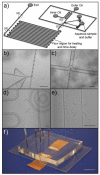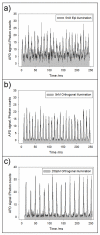Ultrasensitive and high-throughput fluorescence analysis of droplet contents with orthogonal line confocal excitation
- PMID: 21062029
- PMCID: PMC2995829
- DOI: 10.1021/ac102173m
Ultrasensitive and high-throughput fluorescence analysis of droplet contents with orthogonal line confocal excitation
Abstract
This paper describes a simple modification to traditional confocal fluorescence detection that greatly improves signal-to-noise (s/n) for the high-speed analysis of droplet streams. Rather than using the conventional epi geometry, illumination of the droplet was in the form of a line that is orthogonal to both the direction of flow and the light-collection objective. In contrast to the epi geometry where we observed high levels of scattering background from the droplets, we detected more than 10-fold less background (depending on the laser power used) when orthogonal-line-confocal illumination was used. We characterized this improvement using a standard microfluidic platform over a range of analyte concentrations and observed an improvement in limits of detection of greater than 10. Using this method, we were able to analyze picomolar concentrations of analytes contained within picoliter-volume droplets at a rate of greater than 350 droplets per second.
Figures





References
-
- Srinivasan V, Pamula VK, Fair RB. An integrated digital microfluidic lab-on-a-chip for clinical diagnostics on human physiological fluids. Lab on a Chip. 2004;4(4):310–315. - PubMed
-
- Hong JW, Quake SR. Integrated nanoliter systems. Nat Biotech. 2003;21(10):1179–1183. - PubMed
-
- Barbulovic-Nad I, Yang H, Park PS, Wheeler AR. Digital microfluidics for cell-based assays. Lab on a Chip. 2008;8(4):519–526. - PubMed
-
- Sinclair J, Pihl J, Olofsson J, Karlsson M, Jardemark K, Chiu DT, Orwar O. A cell-based bar code reader for high-throughput screening of ion channel-ligand interactions. Analytical Chemistry. 2002;74(24):6133–6138. - PubMed
Publication types
MeSH terms
Substances
Grants and funding
LinkOut - more resources
Full Text Sources
Other Literature Sources

